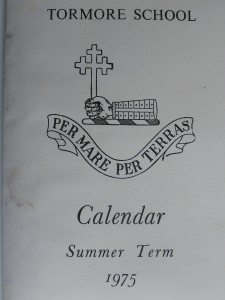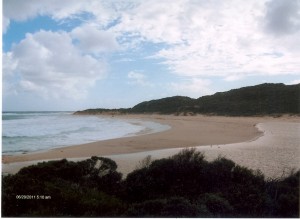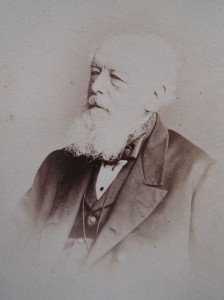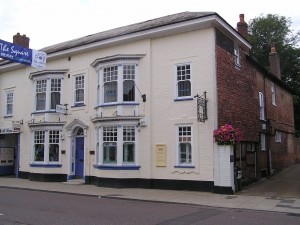Fergus Daly, M.A., Ph.D., Honorary Professor of Medicine at the University of St Andrews, is an authority on Bell’s Palsy. He is the classic erudite, unassuming Tormorian and, though our paths never crossed, I am delighted to publish his memories of the school, not only as a boy in the 1960s but as a locum master in the late 1970s.
I was a pupil at Tormore 1961-66, “Terrier”, good at Maths but not much else (and certainly not Games or the annual sheer purgatory of Swimming). I won a scholarship to King’s Canterbury along with a couple of others that year (Andrew Chamberlin (top scholar) and David Bolam). What a stunning establishment of learning Tormore was.
I am not on Facebook and therefore have some difficulties with accessing output and can provide no input through that medium! but (briefly) like some others my memories of Myles Raven are not remotely alarming but are of a kind and energetic teacher whom I later recognised as a scholar.
I do not have the original but recall his end-of-term report (Latin) in 6B. His underlining: “This boy is idle. One day he will learn that only real hard work brings any great reward.” Witnessing receipt of that commentary at home was not at all good fun.
Michael Strevens taught German, unaccountably amused by my repeated bizarre pronunciation of the German for the number 6, which I just could not get right. And History, which I loathed but for quite other bitter reasons than Michael’s teaching. Additionally and incidentally he provided one-to-one an extensive foundation in Formal Symbolic Logic. Just astonishing, at a prep school, aged 12.
I lived locally though I was a boarder throughout. I don’t think there were such things as day boys? I remember being taken to The Yews on my first day: “Mum! Who sleeps in all these beds?” I had no notion of what was about to happen. My mother was a widow. Simon Raven greeted her affectionately and in an old-fashioned manner whenever they crossed paths in Deal. Myles Raven, David Tarran and Mike Strevens invited her to dinner in the Old House and she had a marvellous evening. She was driving; but between the three of them prodigious amounts of alcohol were consumed. She visited our former matron Miss Gardiner at a care home when the latter lost her mind. I have many memories of “bath time” with this devoted, strict, “correct” matron. (Also of her predecessor Miss Pieper and squadrons of usually Dutch under-matrons.)
When my mother heard of Myles’ stroke in 1976 she advised me of this (as I was just about to graduate from the University of St Andrews) and I offered my services to John Hare as a locum. They were accepted. I did not graduate and simply went to live on site for what remained of the summer term. I lived in what had been the Rediffusion television room. Anybody remember that? Myles died days later. For 4 years afterwards I worked there every summer term freeing John to pursue end-of-year headmasterly tasks. They were just wonderful halcyon summers. John’s wife Mo was utterly charming. My mother and I met her in Tesco years later after John’s devastating and somewhat early death from lung cancer.
In 1980 Simon gave me his black Morris Traveller regd YOB 678, the very car in which Myles drove me and others to cricket matches during two Summer terms in 1965 and 1966. (I was First XI scorer.) I recall Myles checking that the handbrake was Off roughly every 20 seconds throughout every journey. That car from another era lasted me for years.
I wonder about the current circumstances of some contemporaries and staff. Michael Strevens’ brother Pip married a school friend of my four sisters and I think Michael also married somewhat late. Pip died a while ago .. .. I am just a kick off 71 .. .. I wonder if Michael is still with us .. .. I do have some contact details not yet attempted. I met him last on the platform of Swindon railway station in 1979 and we had just time to agree our opinion that Simon’s latest book “The Roses of Picardie” was a load of rubbish before our different train schedules dictated our parting. But also: any of: the two Melville brothers Charles and David (“Glinter”) with whom I stayed one holiday – we went sailing? Richard Hollis (likewise, and I remember particularly his kind mother and sister – his father drove me about in their Daimler with a pre-selector gearbox, explaining the mechanism in detail)? I had a brief work-related correspondence with Ruairidh Milne a few years ago. I am most amiably in touch with Tim Willasey-Wilsey who was also a contemporary at St Andrews.
Blissful days interspersed with miserable moments. Sometimes it probably felt more like miserable days interspersed with slightly less miserable moments but hindsight reveals all – and as so many in this forum have agreed, Tormore was a very special institution even amongst the plethora of similar establishments dotted along the South coast of England. Happy times. Hope all well with all reading this.
Rupert Willoughby comments: honest reports such as ‘Bird’s’ are no longer permitted in schools. They have to be relentlessly positive (I speak from experience).
Day boys arrived, I think, in the early 1970s, as a response to falling numbers. They were regarded with suspicion and no little envy for their comfortable home lives.
I am not sure I can identify the ‘Rediffusion Room’. In my day (early 1970s) there was a black and white telly in the Mem Room, to which we had limited exposure. As an occasional treat we would be allowed into the Headmaster’s drawing room, where I remember seeing Princess Anne’s wedding and also being introduced one Saturday evening to ‘Candid Camera’ . To be able to sit on a comfortable chair or even a carpet was a rare treat.
A lot of people speak better of ‘Bird’ in his younger days. He must have been very jaded by the time I knew him. I think the detail about his nervously checking the brake is very telling – quite an insecure and unconfident fellow.
Fergus describes what I think was our common experience as boarders; he also highlights the brilliance of the teaching. More memories in this vein will be very welcome.




